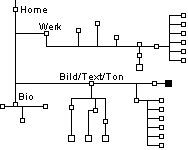|
|
Anna Oppermann:  Umarmungen, Unerklärliches und eine Gedichtzeile von R. M. R. Umarmungen, Unerklärliches und eine Gedichtzeile von R. M. R.
 I. in Katalog: Das Verhältnis der Geschlechter, Pfaffenweiler 1989, S. 86-92 (der Absatz I. in Katalog: Das Verhältnis der Geschlechter, Pfaffenweiler 1989, S. 86-92 (der Absatz
"Thema, Stichworte" in gekürzter Variante bereits abgedruckt in Katalog: Anna
Oppermann Ensembles 1968-1984, Hamburg und Brüssel 1984, S. 106-107)
 II. English translation II. English translation
|
|
